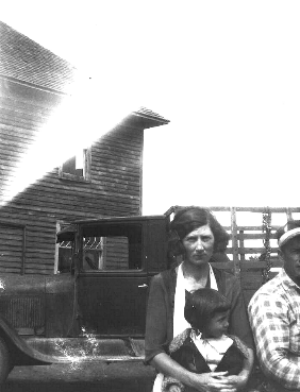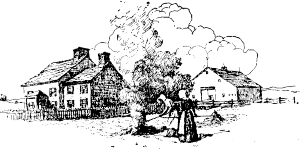In 1924, the year I was twenty I didn't get a school so I went to work in the
Brainerd Hospital as a nurse's aid.

Olive Harrington Vellas, James Vellas and Stacy Vellas My first child was born in Pete Roebuck's house near Fred Berg's place in Macville Township on November 25, 1927. Jim named her Anastasia after himself. 'Anastasios' was his Greek name. When she was three months old we moved to Hibbing where a lot of Greeks lived. I stayed home and took care of our livestock when we lived in Hibbing. I had to be there to take care of the place and be able to sell our wares when people came around to buy. I had to show them the merchandise Jim had and how much money he wanted for it. The Greek people in Hibbing treated me very nice, though I couldn't understand much of what they were saying. But when you have a baby it doesn't matter what language you speak, they all want to see your baby and hold your baby and pet your baby. You know how it is. So, there was a common bond. Jim didn't take me along after I had the baby. His trips were too long and hard. He would travel as far away as Minneapolis and St. Paul then he'd come back. His truck had an open cab with a shingled roof and no doors. They used to make them that way. It was shingled on the top like a house. In the winter it was very cold riding in the open truck. We lived in Swatara for a while, too, after we were married. Jim bought a carload (railroad car) of grain and had it shipped into Swatara. We kept it in a warehouse. I stayed home and sold the grain to the farmers. We cut prices on Art Heath and the other storekeepers. They were mad, but we didn't care. They called Jim, "Jessie James" because they resented us selling the grain for less than they were selling theirs. I sold it, anyway. When people came for grain, I went out and opened the warehouse. They paid me the money and I stayed there until they loaded the prescribed amount of grain and then I locked up. The farmers bought the grain to feed to their livestock. In 1928, Jim bought a new Model T Ford Truck. In 1929, the stock market crashed. Jim had a new truck but the people in Northern Minnesota had no money to buy anything. He had 80 acres in the Haypoint area so we moved out there. We didn't have a house on the land so we asked if we could live in the Weber's house. We lived there rent-free as we had no money. Jim raised rutabagas on his farm and hunted deer for meat. Connie, Constantine James, our son was born on the Weber place. The doctor came out to Haypoint from Hill City to deliver him at the house. The doctors in that day were not as aware of germs. In a few days I came down with Jaundice and Jim took me to the Grand Rapids hospital. He took Stacy and left her with Mrs. Schindele until I came home. No one made out the birth record for Connie. We moved to the homestead when Connie was two years old in 1933. Times were still very hard for everyone during the depression. The taxes were $160.00 a year for the 160-acre homestead but we didn't pay any taxes. Jim got a group of men together and they built the log house on the farm. My dad helped. He built the upstairs floor and the downstairs floor. The men Jim hired just put up the outside of the house. After my mother died in 1925, my Dad took Elsie and they went to Fort Madison to find work. Elsie worked in the pen factory and stayed with Aunt Ella Jones. Dad worked for a man with a second-hand shop. Aunt Ella also worked at the pen factory. My dad decided to come home in 1932. When he got home he stopped at his son Newlon's who lived on the adjoining property in Cass County. He started to leave for his own homestead when Newlon said, "Don't go, the place has burned to ground. There is nothing left. At first he stayed with my brother Newlon. Then Newlon turned him out and we found him walking along the road and we took him home with us. He stayed at our house until he died on January 31, 1937. copyright 1979 Olive Harrington Transcribed by Stacy Vellas  |
